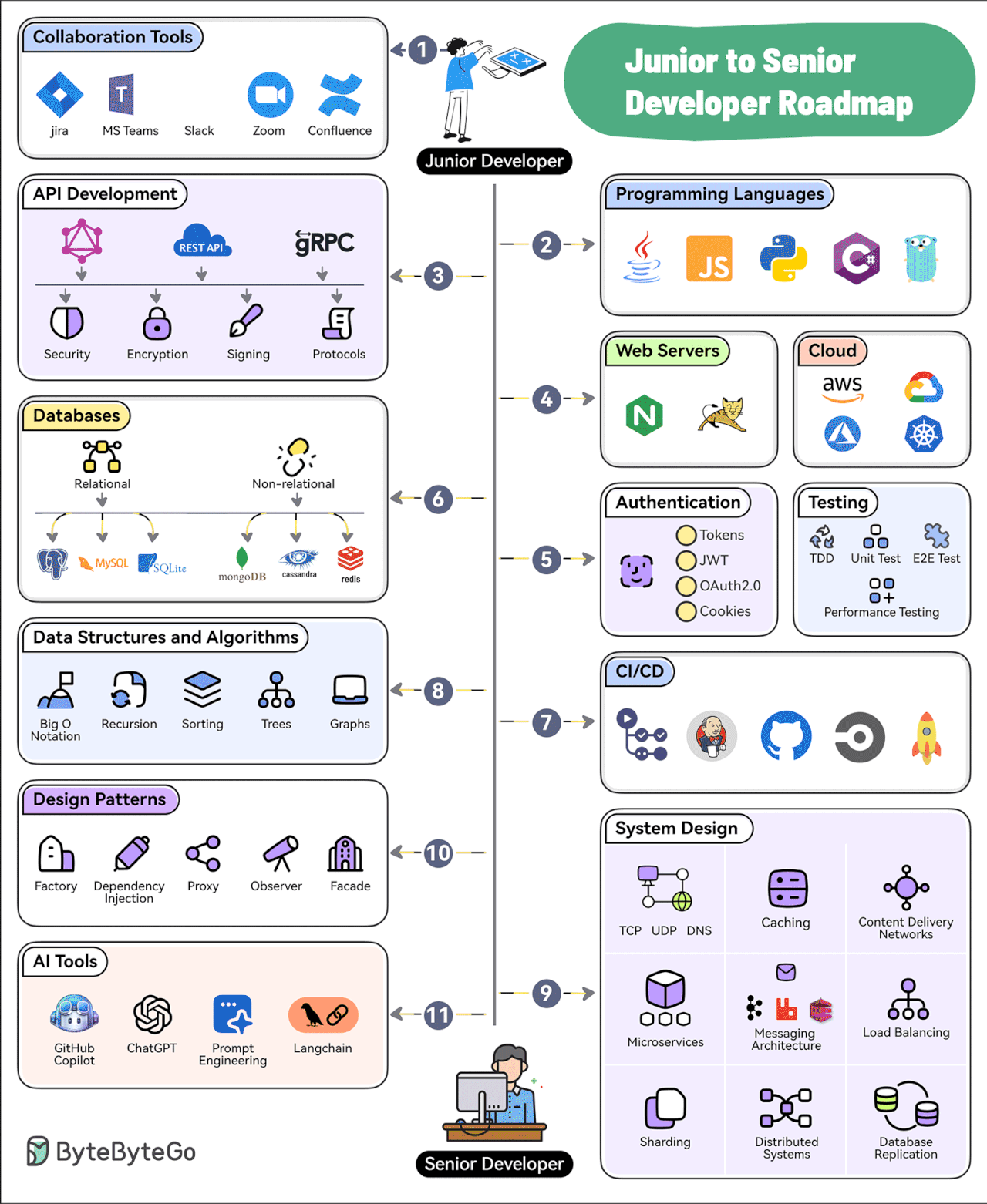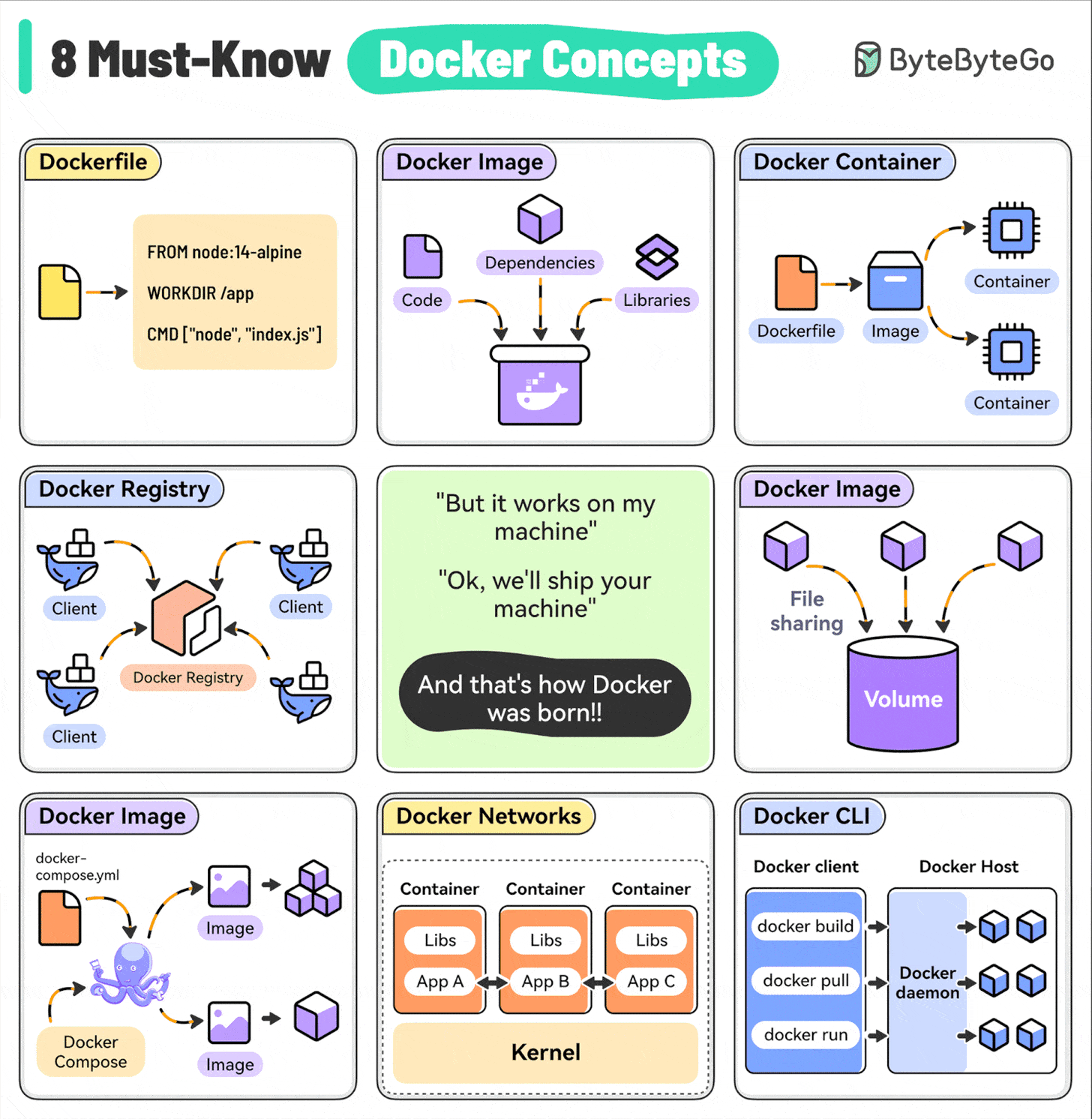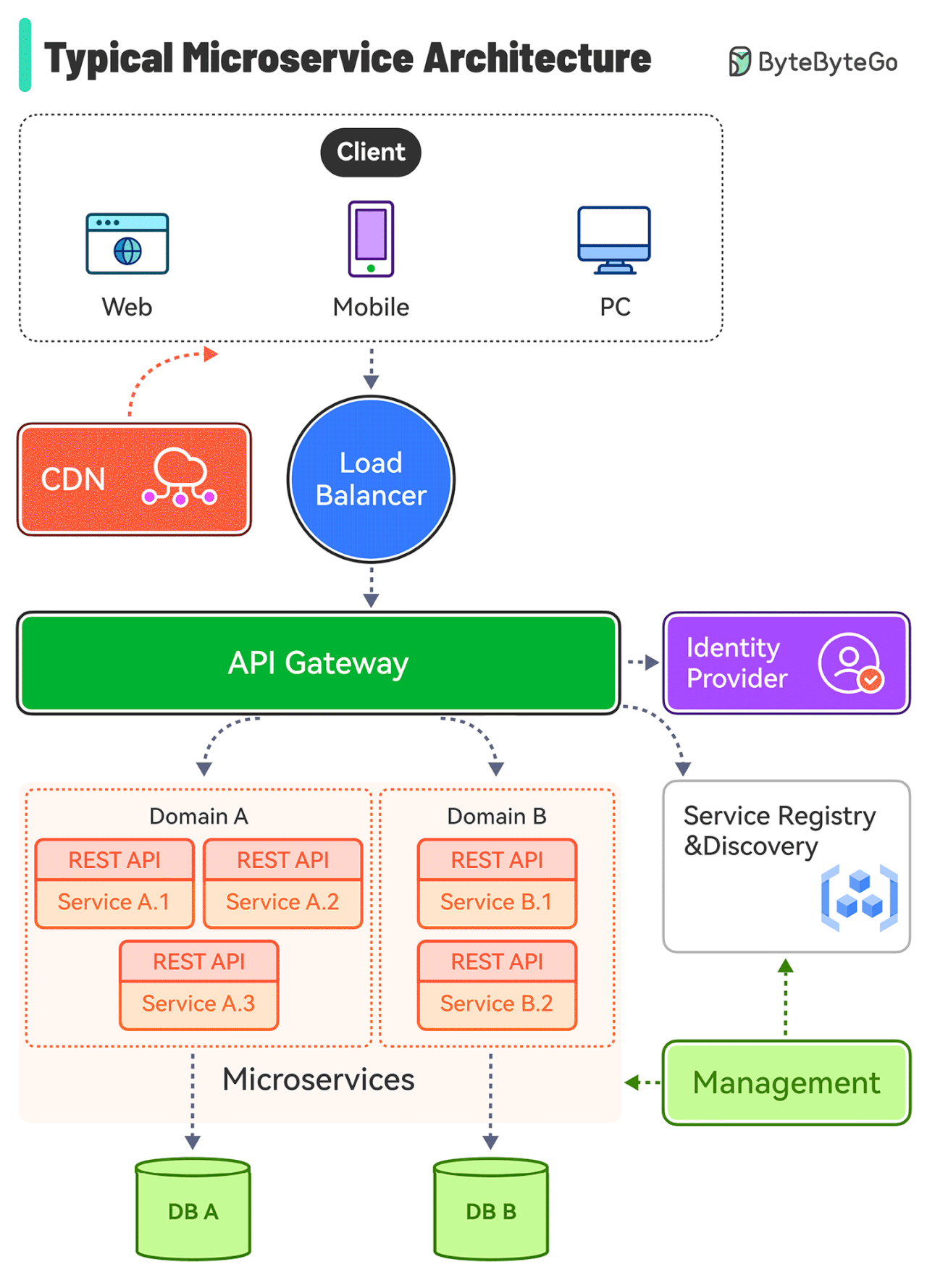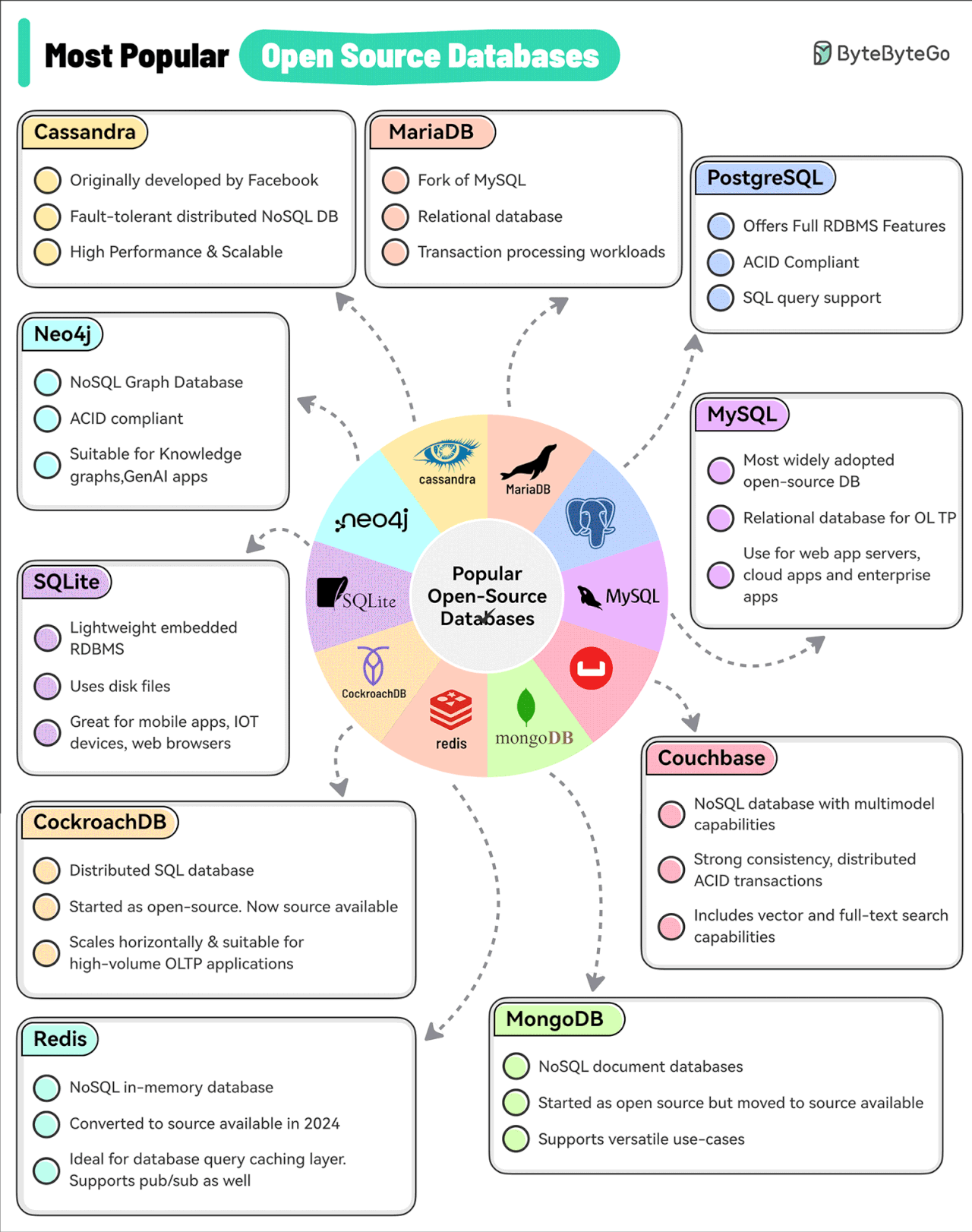EP116: 11 steps to go from Junior to Senior Developer
This week’s system design refresher:
What is Data Pipeline? | Why Is It So Popular? (Youtube video)
11 steps to go from Junior to Senior Developer
Top 8 must-know Docker concepts
What does a typical microservice architecture look like?
Top 10 Most Popular Open-Source Databases
SPONSOR US
New Relic Digital Monitoring Experience (DEM) (Sponsored)
New Relic DEM solutions are designed to provide comprehensive insights into digital operations, allowing teams to optimize user experiences in real time.
Download the datasheet for an overview of New Relic DEM capabilities:
Real user monitoring (RUM): Browser monitoring and mobile monitoring
Pixel-perfect replays: Session replay
Proactive issue detection: Synthetic monitoring, mobile user journeys (crash analysis), and error tracking (errors inbox)
Integration and collaboration: In-app collaboration capabilities
What is Data Pipeline? | Why Is It So Popular?
11 steps to go from Junior to Senior Developer
Collaboration Tools
Software development is a social activity. Learn to use collaboration tools like Jira, Confluence, Slack, MS Teams, Zoom, etc.Programming Languages
Pick and master one or two programming languages. Choose from options like Java, Python, JavaScript, C#, Go, etc.API Development
Learn the ins and outs of API Development approaches such as REST, GraphQL, and gRPC.Web Servers and Hosting
Know about web servers as well as cloud platforms like AWS, Azure, GCP, and KubernetesAuthentication and Testing
Learn how to secure your applications with authentication techniques such as JWTs, OAuth2, etc. Also, master testing techniques like TDD, E2E Testing, and Performance TestingDatabases
Learn to work with relational (Postgres, MySQL, and SQLite) and non-relational databases (MongoDB, Cassandra, and Redis).CI/CD
Pick tools like GitHub Actions, Jenkins, or CircleCI to learn about continuous integration and continuous delivery.Data Structures and Algorithms
Master the basics of DSA with topics like Big O Notation, Sorting, Trees, and Graphs.System Design
Learn System Design concepts such as Networking, Caching, CDNs, Microservices, Messaging, Load Balancing, Replication, Distributed Systems, etc.Design patterns
Master the application of design patterns such as dependency injection, factory, proxy, observers, and facade.AI Tools
To future-proof your career, learn to leverage AI tools like GitHub Copilot, ChatGPT, Langchain, and Prompt Engineering.
Over to you: What else would you add to the roadmap?
Latest articles
If you’re not a paid subscriber, here’s what you missed.
To receive all the full articles and support ByteByteGo, consider subscribing:
Top 8 must-know Docker concepts
Dockerfile: It contains the instructions to build a Docker image by specifying the base image, dependencies, and run command.
Docker Image: A lightweight, standalone package that includes everything (code, libraries, and dependencies) needed to run your application. Images are built from a Dockerfile and can be versioned.
Docker Container: A running instance of a Docker image. Containers are isolated from each other and the host system, providing a secure and reproducible environment for running your apps.
Docker Registry: A centralized repository for storing and distributing Docker images. For example, Docker Hub is the default public registry but you can also set up private registries.
Docker Volumes: A way to persist data generated by containers. Volumes are outside the container’s file system and can be shared between multiple containers.
Docker Compose: A tool for defining and running multi-container Docker applications, making it easy to manage the entire stack.
Docker Networks: Used to enable communication between containers and the host system. Custom networks can isolate containers or enable selective communication.
Docker CLI: The primary way to interact with Docker, providing commands for building images, running containers, managing volumes, and performing other operations.
Over to you: What other concept should one know about Docker?
What does a typical microservice architecture look like? 👇
The diagram below shows a typical microservice architecture.
Load Balancer: This distributes incoming traffic across multiple backend services.
CDN (Content Delivery Network): CDN is a group of geographically distributed servers that hold static content for faster delivery. The clients look for content in CDN first, then progress to backend services.
API Gateway: This handles incoming requests and routes them to the relevant services. It talks to the identity provider and service discovery.
Identity Provider: This handles authentication and authorization for users.
Service Registry & Discovery: Microservice registration and discovery happen in this component, and the API gateway looks for relevant services in this component to talk to.
Management: This component is responsible for monitoring the services.
Microservices: Microservices are designed and deployed in different domains. Each domain has its database.
Over to you:
What are the drawbacks of the microservice architecture?
Have you seen a monolithic system be transformed into microservice architecture? How long does it take?
Top 10 Most Popular Open-Source Databases
This list is based on factors like adoption, industry impact, and the general awareness of the database among the developer community.
MySQL
PostgreSQL
MariaDB
Apache Cassandra
Neo4j
SQLite
CockroachDB
Redis
MongoDB
Couchbase
Over to you: Which other database would you add to this list?
SPONSOR US
Get your product in front of more than 500,000 tech professionals.
Our newsletter puts your products and services directly in front of an audience that matters - hundreds of thousands of engineering leaders and senior engineers - who have influence over significant tech decisions and big purchases.
Space Fills Up Fast - Reserve Today
Ad spots typically sell out about 4 weeks in advance. To ensure your ad reaches this influential audience, reserve your space now by emailing hi@bytebytego.com








This covers the technical skillsets aspects well, but the journey would be incomplete without learning how to positively impact others through mentoring, collaborstion and teamwork, i.e., making the people around you better. Cricital thinking, decision-making, and business accumen also come to mind.
This is incredible!! Thanks for sharing!!